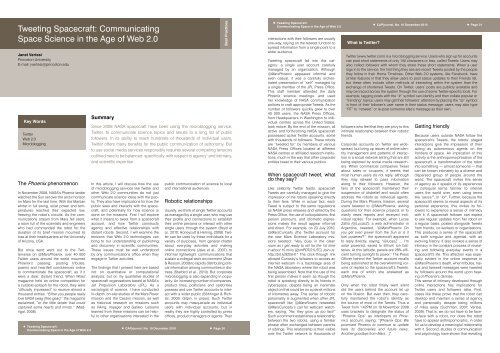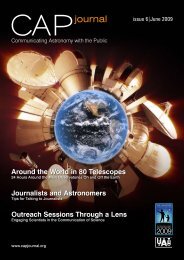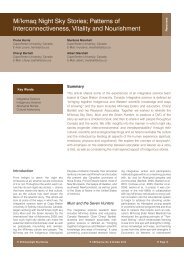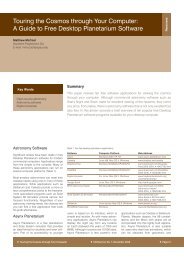Tweeting Spacecraft - Communicating Astronomy with the Public ...
Tweeting Spacecraft - Communicating Astronomy with the Public ...
Tweeting Spacecraft - Communicating Astronomy with the Public ...
You also want an ePaper? Increase the reach of your titles
YUMPU automatically turns print PDFs into web optimized ePapers that Google loves.
• CAPjournal, No. 10 December 2010<strong>Tweeting</strong> <strong>Spacecraft</strong>: <strong>Communicating</strong>• <strong>Tweeting</strong> <strong>Spacecraft</strong>:<strong>Communicating</strong> Space in <strong>the</strong> Age of Web 2.0• Page 31phrase often exchanged between parents promised Phoenix to continue to update for us to develop a meaningful relationship• <strong>Tweeting</strong> <strong>Spacecraft</strong>:<strong>Communicating</strong> Space in <strong>the</strong> Age of Web 2.0 • CAPjournal, No. 10 December 2010 • Page 30 or siblings. This relationship is <strong>the</strong>n visible here its discoveries and future news. <strong>with</strong> it. Second, studies of communicationinteractions <strong>with</strong> <strong>the</strong>ir followers are usuallySpace Science in <strong>the</strong> Age of Web 2.0one-way, relying on <strong>the</strong> retweet function to What is Twitter?spread information from a single point to awider audience.Janet VertesiTwitter (www.twitter.com) is a microblogging service. Users who sign up for accountsPrinceton University<strong>Tweeting</strong> spacecraft fall into this category:can post short statements of only 140 characters or less, called Tweets. Users mayE-mail: jvertesi@princeton.edua single user account carefully also collect followers <strong>with</strong> whom <strong>the</strong>y share <strong>the</strong>se short statements. When a usermanaged by an organisation. Although logs in to <strong>the</strong> service, <strong>the</strong> first thing <strong>the</strong>y see are recent Tweets posted by <strong>the</strong> people@MarsPhoenix appeared informal and <strong>the</strong>y follow in <strong>the</strong>ir Home Timelines. O<strong>the</strong>r Web 2.0 systems, like Facebook, haveeven casual, it was a carefully orchestratedsimilar features in that <strong>the</strong>y allow users to post status updates to <strong>the</strong>ir Friends list,presentation of “self” managed by but <strong>the</strong>se often include o<strong>the</strong>r methods of interacting <strong>with</strong>in <strong>the</strong> system than <strong>the</strong>a single member of <strong>the</strong> JPL Press Office. exchange of shortened Tweets. On Twitter, users’ posts are publicly available andThis staff member attended <strong>the</strong> daily may be traced across <strong>the</strong> system through <strong>the</strong> use of some Twitter-specific tools. ForPhoenix science meetings, and used example, tagging posts <strong>with</strong> <strong>the</strong> “#” symbol can identify and <strong>the</strong>n collate popular orher knowledge of NASA communication “trending” topics; users may get <strong>the</strong>ir followers’ attention by placing <strong>the</strong> “@” symbolpolicies to craft appropriate Tweets. As <strong>the</strong> in front of <strong>the</strong>ir follower’s user name in <strong>the</strong>ir status message; users may also typenumber of followers quickly grew to over “RT” to “retweet” or re-post someone else’s message as <strong>the</strong>ir own.Key WordsSummary40 000 users, <strong>the</strong> NASA Press Offices,from Headquarters in Washington to individualcentres across <strong>the</strong> United States,Since 2008 NASA spacecraft have been using <strong>the</strong> microblogging service,took notice. By <strong>the</strong> end of <strong>the</strong> mission, all followers who feel that <strong>the</strong>y are privy to this Getting friendlyTwitterTwitter, to communicate science topics and results to a long list of publicactive and forthcoming NASA spacecraft intimate relationship between <strong>the</strong>ir roboticpossessed active Twitter accounts, some friends.Because users outside NASA follow <strong>the</strong>Web 2.0followers. In its ability to reach hundreds of thousands of individual users,<strong>with</strong> thousands of followers. These robotsspacecraft’s Tweets, <strong>the</strong> robots’ stagedMicrobloggingTwitter offers many benefits for <strong>the</strong> public communication of astronomy. Butare “tweeted for” by members of various Corporate accounts on Twitter are widespread,interactions give <strong>the</strong> impression of <strong>the</strong>irbut bring up issues of online iden-acting as autonomous agents on <strong>the</strong>to use social media services responsibly requires several competing tensionsNASA Press Offices located at differentNASA centres or affiliated research institutions,much in <strong>the</strong> way that o<strong>the</strong>r corporate tion in a social network setting that are still activity is <strong>the</strong> anthropomorphisation of <strong>the</strong>tity management and patterns of interac-frontiers of space. An implication of thisoutlined here to be balanced: specifically, <strong>with</strong> respect to agency 1 and intimacy,and scientific expertise.entities tweet to <strong>the</strong>ir various publics. being explored by social media researchers.spacecraft, a transformation of <strong>the</strong> robotWhen commercial companies Tweet into something — almost someone — thatabout sales or coupons, it seems that can be known intimately by a diverse andWhen spacecraft tweet, what most human users do not reply, although dispersed group of people around <strong>the</strong>do <strong>the</strong>y say?<strong>the</strong>y may retweet to pass information world. The spacecraft invites this senseThe Phoenix phenomenon In this article, I will discuss how <strong>the</strong> use public communication of science to localalong to <strong>the</strong>ir followers. However, <strong>the</strong> of agency as it speaks of its experiencesof microblogging services like Twitter and and international audiences.Like celebrity Twitter feeds, spacecraft fans of <strong>the</strong> spacecraft maintained <strong>the</strong>ir in colloquial terms familiar to internetIn November 2008, NASA’s Phoenix lander o<strong>the</strong>r Web 2.0 communities do not justTweets are carefully managed to give <strong>the</strong> suspension of disbelief and would often users <strong>the</strong> world over, even using termswatched <strong>the</strong> Sun set over <strong>the</strong> arctic horizon communicate science ideas <strong>with</strong> <strong>the</strong> public.They also have implications for how <strong>the</strong> Robotic relationshipsto <strong>the</strong>ir fans. While in actual fact, each During <strong>the</strong> Mars Phoenix mission, several spacecraft seems to reveal aspects of itsimpression of <strong>the</strong> robots speaking directly address <strong>the</strong> robots as individual agents. like “yesss!”, or “lol”. Fur<strong>the</strong>r, because <strong>the</strong>on Mars for <strong>the</strong> last time. With <strong>the</strong> Martianwinter in full swing, solar power and temperaturespublic sees and interacts <strong>with</strong> <strong>the</strong> space-Tweet is subject to <strong>the</strong> same regulations users tweeted to @MarsPhoenix, asking personal experience, this invites its fol-reached <strong>the</strong>ir expected low, craft; and potentially for how science is Usually, we think of single Twitter accountsas NASA press releases and vetted by <strong>the</strong> questions for <strong>the</strong>ir science projects or to lowers to experience a sense of intimacyfreezing <strong>the</strong> robot’s circuits. As <strong>the</strong> communicationsdone on <strong>the</strong> missions. First I will explore as managed by a single user, who may usePress Office, <strong>the</strong> use of colloquialisms, first clarify news reports and received indi-<strong>with</strong> it. A spacecraft follower can expectstream from Mars fell silent, what it means to tweet from a spacecraft <strong>the</strong>ir profile and connections to establishperson pronouns, and idiomatic expresvidualreplies. For example, when Lucas to see regular updates from her robot ona room full of <strong>the</strong> scientists and engineers account, and how Twitter constructs <strong>the</strong>ir online persona or interact <strong>with</strong> o<strong>the</strong>rsions makes <strong>the</strong> result appear informal Zallio (@LucasZ), a web administrator in a regular basis, posted alongside Tweetswho had commanded <strong>the</strong> robot for <strong>the</strong> agency and affective relationships <strong>with</strong> single users through <strong>the</strong> system (Boyd etand direct. For example, on 23 July 2010, Argentina, tweeted, “@MarsPhoenix Do from friends, co-workers or organisations.duration of its brief mission mourned its distant robots. Second, I will examine <strong>the</strong> al., 2010; Honeycutt & Herring, 2009). Twitter@MarsCuriosity (<strong>the</strong> Twitter account for you get oven power from <strong>the</strong> Sun or is it This produces a sense of <strong>the</strong> spacecraftloss at <strong>the</strong>ir headquarters at <strong>the</strong> University tensions that Web 2.0 technologies cancan be used by <strong>the</strong>se individuals for a<strong>the</strong> new Mars Science Laboratory mis-fuel powered?”, <strong>the</strong> spacecraft appeared as both singular and agential, <strong>with</strong> anof Arizona, USA.bring to our understanding of publishing variety of purposes, from general chattersion) tweeted: “Very busy in <strong>the</strong> clean to reply directly, saying, “@lucasZ … I’m evolving history. It also invokes a sense ofand discovery in scientific communities. about everyday activities and makingroom as I get ready to roll for <strong>the</strong> 1st time solar powered, saved to lithium ion batteries.intimacy in <strong>the</strong> constant process of reveal-But once word went out to <strong>the</strong> TwitterverseThese issues must be well understood online connections (Java et al., 2007), toin about 15 mins (2pmPDT/21UTC) Join us:At this latitude, panels are 28% effiingand following everyday events in aon @MarsPhoenix, over 40 000 by any communications office when <strong>the</strong>y informal lightweight communications thathttp://bit.ly/92t5HI.” The click-through link cient turning sunlight to power.” The Press spacecraft’s life. This affection was espe-Twitter users around <strong>the</strong> world mourned engage in Twitter activities.sustain a collegial work environment (Zhaoallowed Curiosity’s followers to access an Officer behind <strong>the</strong> Twitter account recalls cially evident in <strong>the</strong> online response toPhoenix’s passing, posting tributes,& Rosson, 2009) to rapidly distributing criticalinternet webcam in a backstage area of being astonished at <strong>the</strong> overwhelming vol-@MarsPhoenix’s death, when tributes, hai-poems and heartfelt condolences online The findings that I present here are basedinformation among communities in dis-<strong>the</strong> NASA laboratory where <strong>the</strong> robot was ume of replies to <strong>the</strong> spacecraft’s Tweets, kus and farewell messages were tweetedto commemorate <strong>the</strong> spacecraft, as if it not on quantitative or computational tress (Starbird et al., 2010). But corporatebeing assembled. Note that <strong>the</strong> use of <strong>the</strong> each one of which she answered as by followers around <strong>the</strong> world upon hearingwere a dear, distant friend. When Wired analysis, but on my qualitative studies of microblogging is also expanding in popularity.first person makes it seem as though <strong>the</strong> @MarsPhoenix.of Phoenix’s demise.magazine held an online competition for spacecraft organisations based at NASA’sAn increasing number of companies,robot is speaking directly to its friends inThis sense of intimacy developed througha suitable epitaph for <strong>the</strong> robot, <strong>the</strong>y were Jet Propulsion Laboratory (JPL). As a product lines, politicians and celebritiescyberspace, despite being an inanimate Only when <strong>the</strong> robot finally went silent online interactions has implications for“officially impressed” to receive almost a sociologist of science, I have conducted possess and use Twitter accounts to interactobject on that could be on a planet millions did <strong>the</strong> users behind <strong>the</strong> account let up Twitter users and followers alike. First,thousand entries. “Ei<strong>the</strong>r you people really in-depth, on-site studies of <strong>the</strong> Mars Rover<strong>with</strong> a wider public (Böhringer & Rich-of kilometres away. This sense of robotic on <strong>the</strong> illusion. But even <strong>the</strong>n, <strong>the</strong>y care-cases like <strong>the</strong>se prove that <strong>the</strong> robot canlove NASA swag [free gear],” <strong>the</strong> magazine mission and <strong>the</strong> Cassini mission, as well ter, 2009; Gilpin, in press). Such Twitterpersonality is augmented when o<strong>the</strong>r JPL fully maintained <strong>the</strong> robot’s identity as develop and maintain a sense of agencyexclaimed, “or <strong>the</strong> little lander that could as historical research on missions such accounts may masquerade as individualspacecraft like @MarsRovers retweeted <strong>the</strong> source of most of <strong>the</strong> Tweets. Thus a and personality despite being millionscaptured some hearts and minds.” (Madrigal,as Viking, Voyager and Galileo. Lessons users <strong>with</strong> individual accounts, but in@MarsCuriosity’s call for webcam watch-Tweet from 1:42PM on 10 November 2008 of miles away (Suchman, 2007; Vertesi,2008)learned from <strong>the</strong>se missions can be help-reality <strong>the</strong>y are highly controlled by pressers, saying, “Aw, <strong>the</strong>y grow up too fast!” uses brackets to designate <strong>the</strong> status of 2009). That is, we do not have to be face-ful to o<strong>the</strong>r organisations interested in <strong>the</strong> offices, product managers or agents. TheirSuch a comment establishes a relationship “Phoenix Ops” as interlopers on Phoenix’sto-face <strong>with</strong> a robot, nor does <strong>the</strong> robotbetween <strong>the</strong> two robots, using a familiaraccount, saying: “[Phoenix Ops: We have to appear anthropomorphic, in orderover <strong>the</strong> Twitter network to thousands of Ano<strong>the</strong>r goodbye from Mars…]”and psychology have shown that revealingBest Practices
details about one’s private life builds a perceivedsense of intimacy between two individuals,often as strongly felt on <strong>the</strong> revealer’sside as that of <strong>the</strong> confidant (Collins &Miller, 1994; Levinger & Huesmann, 1980).Such perceived intimacy may contribute to<strong>the</strong> sense of success on behalf of NASAoutreach personnel. That a low-budget,short-term, and largely immobile missionsuch as Phoenix could be seen to touch <strong>the</strong>lives (and Twitter Timelines) of thousandspresented a public relations breakthrough.It also suggested that public outreach wasbeing successfully accomplished on anunprecedented scale.But because <strong>the</strong> press offices were controlling<strong>the</strong> information that <strong>the</strong> public receiveddirectly, Twitter seemed to eliminate <strong>the</strong>need for longstanding media practices. In<strong>the</strong> past, press offices had to rely on pressreleases sent to news media outlets, andcould not necessarily control which storieswere printed. As <strong>the</strong> press officer in chargeof <strong>the</strong> Twitter feeds explained, “Mainstreammedia are more likely to cover a bad newsstory than a good story. Twice we had baddays on Phoenix… and that would havebeen all [<strong>the</strong> information] <strong>the</strong>y [i.e. <strong>the</strong>public] were getting. Being able to put outinformation daily changed <strong>the</strong> way peoplethought about <strong>the</strong> mission.” Increasingcontrol over <strong>the</strong> mission story as a whole,instead of being subject only to intermittentnegative reports, can be a tremendoussuccess for mission press offices, but <strong>the</strong>new approach also changes <strong>the</strong> relationshipbetween <strong>the</strong>se offices, <strong>the</strong> public andscience reporters.Web 2.0 and expertiseOver <strong>the</strong> course of Phoenix’s short life,microblogging became increasingly centralto <strong>the</strong> daily work of <strong>the</strong> mission. Twitterand o<strong>the</strong>r Web 2.0 technologies suchas Facebook and blogs have since <strong>the</strong>nbeen harnessed across NASA’s officesto release <strong>the</strong>ir spacecraft’s images innear-real time to <strong>the</strong> public. To date,@CassiniSaturn has 75 000 followers;@MarsRovers has 80 000. Their Tweetsoften include single-line descriptionsabout a discovery, and may include shortlinks to blog posts, images or publishedpapers. As Tweets are retweeted, URLsclicked and blog RSS feeds generated,word of a spacecraft’s activities spreadsquickly. But while this may seem like adream come true for press offices, it isimportant to note that Web 2.0 technologiessuch as wikis and blogs have in <strong>the</strong>past exacerbated a tension between <strong>the</strong>mission press office and <strong>the</strong> participatingscientists. In <strong>the</strong> drive to generate contextfor Twitter feeds, <strong>the</strong>se tensions should beconsidered very carefully so that a strong• <strong>Tweeting</strong> <strong>Spacecraft</strong>:<strong>Communicating</strong> Space in <strong>the</strong> Age of Web 2.0working relationship can be establishedbetween those who operate <strong>the</strong> spacecraftand those who tweet on its behalf.Where does data come from?Taking a picture on Cassini, Phoenix or <strong>the</strong>Mars Rovers takes considerable social andscientific work. First, a scientist must beselected to join <strong>the</strong> mission via a lengthyapplication and review process. Then<strong>the</strong>y must come up <strong>with</strong> a hypo<strong>the</strong>sis, andobservations that might prove or disprovethat hypo<strong>the</strong>sis. Next, <strong>the</strong>y must make acase for that observation such that <strong>the</strong>irteam members support it, which meansnegotiating <strong>with</strong> o<strong>the</strong>r instruments forspacecraft time, bytes and power to take<strong>the</strong> observation. Finally, <strong>the</strong>y may work<strong>with</strong> technical assistants to craft and code<strong>the</strong> observation request for upload to <strong>the</strong>spacecraft. The images, spectral readingsand o<strong>the</strong>r measurements that return from<strong>the</strong> spacecraft are embedded <strong>with</strong>in thisdelicate process. But when <strong>the</strong> spacecraftspeaks <strong>with</strong> a single voice and appears tohave an agency all its own, <strong>the</strong> people whomake <strong>the</strong> spacecraft work seem to disappearand become invisible.This invisibility masks three related issues<strong>with</strong> respect to spacecraft data. First, <strong>the</strong>data that spacecraft collect are nei<strong>the</strong>rneutral nor always inherently shared.Because scientists must compete againsteach o<strong>the</strong>r for <strong>the</strong> privilege of building aninstrument, <strong>the</strong> data that <strong>the</strong>ir instrumentreturns belongs to <strong>the</strong>m and to <strong>the</strong>ir team,and often cannot be easily or intuitivelyunderstood by outsiders. Second, scientistsare cautious about stating anythingabout <strong>the</strong>ir data publicly until it has beensufficiently confirmed, calibrated and subjectto peer review. They <strong>the</strong>refore negotiatefor proprietary or validation periods<strong>with</strong> <strong>the</strong>ir data so that <strong>the</strong>y can be sureto fully understand it and stand behindit when <strong>the</strong>ir findings are released to <strong>the</strong>public and to <strong>the</strong>ir colleagues. Third, manyscientists on missions are anxious thatwhen <strong>the</strong>ir data is released, o<strong>the</strong>rs willsee for <strong>the</strong>mselves what <strong>the</strong> scientists hadhoped to see in <strong>the</strong> first place: that whichinspired <strong>the</strong>m to convince <strong>the</strong>ir colleaguesthat it was worth dedicating spacecrafttime, bytes, and power to take <strong>the</strong> observation.Scientists who express reservationsabout releasing <strong>the</strong>ir data too earlyare usually not being obstinate or selfish,but acting in <strong>the</strong> best interest of <strong>the</strong>ir ownand <strong>the</strong>ir team’s scientific process.Who are <strong>the</strong> experts?With <strong>the</strong> coming of Web 2.0 technologieslike blogs, wikis and amateur webforums, a new expectation of visibility to<strong>the</strong> public has inspired some changes inhow scientists plan and craft <strong>the</strong>ir scientificobservations, discoveries and announcements.Behind <strong>the</strong> scenes, I have oftenobserved planetary scientists exchangingconcerns about what <strong>the</strong> public will thinkof <strong>the</strong> Tweets and blog posts about <strong>the</strong>irdata. There is much anxiety that imagesfrom ano<strong>the</strong>r planet will be misinterpreted,leading to public misunderstandings,or that amateur interpretations of<strong>the</strong>se images will be misinterpreted asprofessional ones. Twitter also brings upcomplex questions about <strong>the</strong> process ofscience. Can significant science contentreally be conveyed in 140 characters orless? Does a Tweet count as a “publication”when it comes to a discovery prioritydispute? What is <strong>the</strong> role of <strong>the</strong> expert inthis new environment? How can scientistspreserve and support <strong>the</strong> public’s respectfor scientific expertise, work and <strong>the</strong> statusof peer-reviewed publications in <strong>the</strong> era of<strong>Tweeting</strong> and retweeting?These anxieties are not unfounded. In January2008, <strong>the</strong>re were reports of an imageof a woman or a Sasquatch on Mars, whichmany people claimed to see in an imagetaken by <strong>the</strong> Mars Rover, Spirit. Althoughquickly discredited by scientists on <strong>the</strong>mission, <strong>the</strong> story was already out of <strong>the</strong>ircontrol. It ga<strong>the</strong>red considerable speedon <strong>the</strong> internet as it was blogged andshared by users <strong>the</strong> world over, and waseven reported by traditional media outletssuch as national television networks andnewspapers (CNN.com, 2008). Similarly,in April 2010, a popular blogger in <strong>the</strong>planetary science community used Photoshopto put toge<strong>the</strong>r her own compositeof images taken by <strong>the</strong> Cassini spacecraft,and posted <strong>the</strong> result <strong>with</strong> a discussion onher blog. This image was picked up andposted as <strong>the</strong> <strong>Astronomy</strong> Image of <strong>the</strong> Dayon a website hosted on a NASA server,no doubt to <strong>the</strong> blogger’s excitement.But conspiracy <strong>the</strong>orists on <strong>the</strong> internetjumped on <strong>the</strong> image, claiming that it wasdoctored to <strong>the</strong> point of being unbelievable,proving that NASA was manipulating<strong>the</strong> public. Both <strong>the</strong> image site and <strong>the</strong>blogger were independent of NASA, but<strong>the</strong> space agency was held accountablefor this interpretation. (see Lakdawalla,2010).Such examples do not come from Twitter,but do speak to some tensions thatWeb 2.0 technologies have generated<strong>with</strong> respect to scientific work. Releasesof data used to be reserved for scientificpublications and major press conferences,wherein a discovery would beappropriately announced — and credited.With Web 2.0, however, <strong>the</strong> expectation ofimmediacy and visibility means that more• CAPjournal, No. 10 December 2010 • Page 32• <strong>Tweeting</strong> <strong>Spacecraft</strong>:<strong>Communicating</strong> Space in <strong>the</strong> Age of Web 2.0space agencies are asking scientists torelease <strong>the</strong>ir data to <strong>the</strong> public sooner:sometimes even before <strong>the</strong>ir colleagueson <strong>the</strong> same mission have seen <strong>the</strong> data.To some scientists, such requests violate<strong>the</strong>ir scientific process, bypassing requirementssuch as peer review, analysis andeven calibration. To be fair, not all scientistswork this way: some missions believeit is important to release all <strong>the</strong>ir imagedata to <strong>the</strong> public as soon as it is acquired.However, in my research on <strong>the</strong> subject,missions launched before 2000 and <strong>the</strong>majority of European space projects aremore likely to include independent teamsthat shepherd <strong>the</strong>ir results. And while oneteam member on an interplanetary missionmay delight in <strong>the</strong> opportunity to have <strong>the</strong>irdata instantly streamed to thousands ofpeople over morning coffee, ano<strong>the</strong>r mayexpress serious reservations about releasingsuch information to <strong>the</strong> public. Whe<strong>the</strong>rone believes that open data is <strong>the</strong> wayforward or not, both perspectives need tobe treated <strong>with</strong> respect and understandingwhen generating content for Twitter feeds.Why, where and when totweet?There are clearly many benefits to startinga Twitter stream for one’s spacecraft orscientific experiment. With a few short keystrokes,a single message can be relayeddirectly to followers around <strong>the</strong> world, bypassing media relations, and allowing <strong>the</strong>public to build an intimate relationship<strong>with</strong> <strong>the</strong>ir spacecraft. For some, this is adream come true, ensuring <strong>the</strong>ir mission’ssuccess and continued public support; foro<strong>the</strong>rs, it suggests a public relations nightmare.But as for any new technology, reapinga cascade of benefits from Web 2.0mission communications requires careful,local consideration of how press officeswill work <strong>with</strong> scientists to release missioninformation responsibly and thoughtfully.This requires thinking about why, when,and where to tweet, and doing so in collaboration<strong>with</strong> each unique mission to hearscientists’ concerns and excitement about<strong>the</strong> new process. Science Press Officeswould be wise to meet <strong>with</strong> <strong>the</strong> scientists<strong>the</strong>y represent to come up <strong>with</strong> internalpolicies for <strong>the</strong> use of Web 2.0 technologiesor “new media.” Such policies shouldaim to balance <strong>the</strong> enthusiasm of <strong>Tweeting</strong>spacecraft on <strong>the</strong> one hand, <strong>with</strong> arespect for local scientific and operationalprocesses on <strong>the</strong> o<strong>the</strong>r. Without such initialcommunication, a rush to embrace Twitterruns <strong>the</strong> risk of generating more badpress than positive public experiences.As <strong>with</strong> any technology, Twitter cannotchange <strong>the</strong> process of science, and wouldbe unwise to try to do so. Instead, to betruly valuable both to <strong>the</strong> scientists andto <strong>the</strong> public, we must bring it mindfullyinto existing relationships, restrictions andways of working <strong>with</strong>in <strong>the</strong> scientific community.After all, <strong>the</strong>se are crucial to getting<strong>the</strong> work of science done in <strong>the</strong> first place.AcknowledgementsThanks to Judy Chen, Irina Shklovski,Victoria McGregor and anonymous NASAmission scientists for comments on earlierdrafts. A version of this paper wasaccepted to <strong>the</strong> CHI 2010 workshop onMicroblogging, in Atlanta, Georgia. Thiswork was funded by <strong>the</strong> National ScienceFoundation’s Virtual Organizations asSociotechnical Systems Program: Officeof Cyberinfrastructure, Grant #0838499.Notes1Agency: Here, specifically referring to <strong>the</strong>received impression that <strong>the</strong> robots and spacecraftare able to act autonomously.References• CAPjournal, No. 10 December 2010 • Page 33• Böhringer, M. & Richter, A. 2009, AdoptingSocial Software to <strong>the</strong> Intranet: ACase Study on Enterprise Microblogging,Proceedings of <strong>the</strong> 9th Mensch & ComputerConference, Berlin, Germany, 293• Boyd, D., Golder, S. & Lotan G. 2010,Tweet Tweet Retweet: ConversationalAspects of Retweeting on Twitter, Proceedingsof 42nd Hawaii InternationalConference on System Sciences,HICSS-43, IEEE: Kauai, HI• Collins, N. & Miller, L. 1994, Self-disclosureand liking: A meta-analytic review,Psychology Bulletin, 116, 3, 457• CNN.com, 2008, The Shot: Man onMars?, http://www.cnn.com/video/#/video/bestoftv/2008/01/23/cooper.shot.tuesday.cnn (Retrieved on 24 November2010)• Gilpin, D. R. Forthcoming, Working <strong>the</strong>Twittersphere: How <strong>Public</strong> RelationsPractitioners Use Microblogging for ProfessionalIdentity Construction, In: TheNetworked Self: Identity, Community andCulture on Social Network Sites, ed. Z.Papacharissi, (Routledge, New York)• Honeycutt, C. & Herring, S. 2009,Beyond microblogging: Conversationand collaboration via Twitter, Proceedingsof 42nd Hawaii International Conferenceon System Sciences, IEEE Press,Los Alamitos, CA• Java, A, Song, X., Finin, T. & Tseng, B2007, Why we Twitter: UnderstandingMicroblogging Usage and Communities,Proceedings of <strong>the</strong> 9th Joint WEBKDDWorkshop, (ACM Press, New York), 56• Lakdawalla, E. 2010, I’m part of <strong>the</strong> conspiracy,apparently, http://planetary.org/blog/article/00002710 (Retrieved on 24November 2010)• Levinger, G. & Huesmann, L. 1980, An“incremental exchange” perspective on<strong>the</strong> pair relationship. In: Social Exchange,Eds. Gergen, K et al., (Plenum Press,New York), 165• Madrigal, A. 2008, @MarsPhoenix’sTwitter Epitaphs, Wired Magazine, http://www.wired.com/wiredscience/2008/11/marsphoenixs-tw/ (Retrieved on 24November 2010)• Starbird, K., Palen, L., Hughes, A. &Vieweg, S. 2010, Chatter on The Red:What Hazards Threat Reveals about <strong>the</strong>Social Life of Microblogged Information,Proceedings of <strong>the</strong> 2010 ACM Conferenceon Computer Supported CooperativeWork, (ACM Press, New York), 241• Suchman, L. 2007, Human-MachineReconfigurations, (Cambridge UniversityPress, Cambridge)• Vertesi, J. 2009, Seeing Like a Rover:Embodied Experience on <strong>the</strong> Mars ExplorationRover Mission, Extended Abstractsof <strong>the</strong> 2008 ACM Conference on HumanFactors in Computing Systems, (ACMPress, New York), 2523• Zhao, D. & Rosson, M. B. 2009, Howand Why People Twitter: The Role thatMicroblogging Plays in Informal Communicationat Work, Proceedings of GROUP2009. (ACM Press, New York), 243BiographyJanet Vertesi is a PhD graduate fromCornell University in Science & TechnologyStudies. Currently she is a Cotsen Fellow at<strong>the</strong> Society of Fellows in <strong>the</strong> Liberal Arts atPrinceton University, where she also holds aLecturer appointment in <strong>the</strong> Sociology Department.Her work focuses on <strong>the</strong> complexintersections between people, science andtechnology such as <strong>the</strong> social organisationof robotic spacecraft teams, and <strong>the</strong>role of images in scientific practice. Sheis currently conducting an ethnographicstudy of <strong>the</strong> Cassini mission to Saturn.More information: http://janet.vertesi.com/









